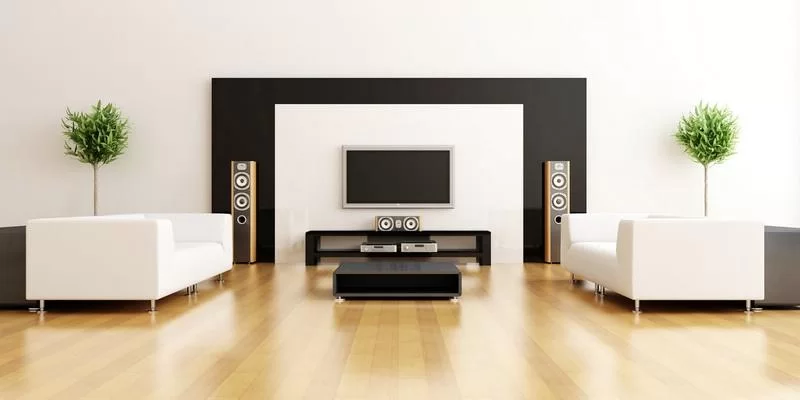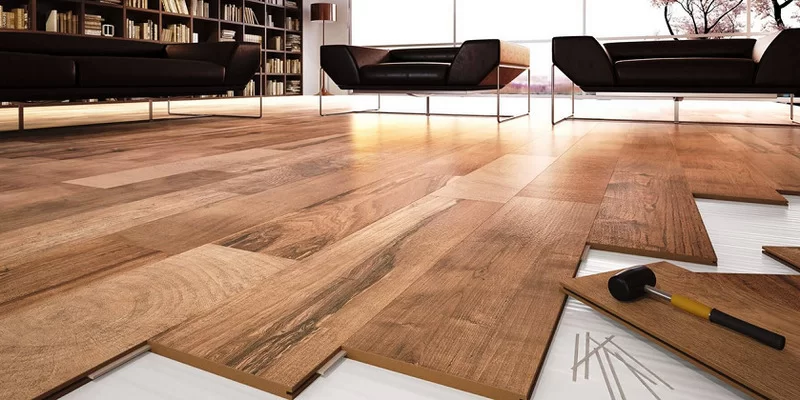
Compare laminate and PVC tiles
Laminate and PVC tiles are two common flooring materials. Our experts in the field of construction and repair made a comparative analysis of these types of flooring, sorted out their advantages and disadvantages, which will help you choose the most suitable one.
Laminate

Laminate is a piece material, which is produced in the form of individual boards or panels with a multilayer structure. The laminate panel consists of the following layers: high density fibreboard backing; the lower stabilizing layer, which serves to protect against deformation during changes in humidity and temperature; a decorative layer that gives a certain color and texture, in most cases — wood, but can also imitate, for example, natural stone; top, front layer of synthetic acrylate resin, protecting against mechanical damage, exposure to solar ultraviolet radiation, chemicals, etc.
It is classified according to wear resistance into 6 categories:
-
class 21 — intended for use in residential areas with low traffic;
-
class 22 — for rooms with medium traffic;
-
class 23 — for rooms with high traffic;
-
classes 31, 32, 33 — for public spaces.
PVC tiles

PVC tiles are piece products similar in composition to PVC linoleum. Are issued in the form of a tile from 300х300 mm in size. PVC tile consists of several layers: a base made of polyvinyl chloride modified with polymer resin, a decorative polymer layer that gives color and pattern, and a top protective layer made of PVC or polyurethane. The total thickness of the tiles is 2-3 mm.
Table of advantages and disadvantages
|
|
|
|
|
Laminate
|
+ high resistance to abrasion, pressure, shock loads;
+ resistance to aggressive chemicals — household chemicals;
+ resistance to solar ultraviolet rays — the laminate does not fade;
+ ease of cleaning and cleaning;
+ ease of installation that does not require highly qualified performers;
+ fire safety — the material belongs to flame-retardant materials;
+ attractive appearance;
+ relatively low price in comparison, for example, with parquet;
+ large selection of decorative design;
+ good maintainability — in case of damage, it is enough to replace one or more planks.
|
— short service life — no more than 10 years, after which the coating must be changed;
— low resistance to moisture, because of this, the material cannot be used in rooms with a high humidity regime;
— high requirements for the evenness of the base, with an uneven base, the coating will warp and creak;
— the top layer of the laminate can accumulate static electricity, which contributes to the accumulation of dust.
|
|
PVC tiles
|
+ great variety in design;
+ high wear resistance, higher than that of similar linoleum;
+ ease of transport and ease of installation;
+ high maintainability — in case of damage, individual tiles are easily replaced;
+ the ability to access communications laid under the floor covering;
+ resistance to moisture, which allows the use of tiles for flooring in rooms with a wet regime;
+ ease of cleaning and care;
+ resistance to solar ultraviolet radiation — the tile does not fade;
+ good soundproofing qualities;
+ high impact resistance — when heavy objects fall, the tile is not damaged;
+ environmental friendliness — the material does not emit any substances harmful to health;
+ fire safety — the material belongs to the category of flame-retardant;
+ does not form static electricity.
|
— insufficient resistance to high temperatures;
— requires a perfectly even base for laying.
|
The main differences between materials
The main differences between laminate and PVC tiles are as follows:
-
are made from completely different components;
-
have different shapes and sizes;
-
differ in the nature of the design;
-
differ in the thickness of the coating, the tile is much thinner than the laminate and does not hide the height of the premises;
-
the tile can be laid directly on the prepared base, while the laminate is laid on a special substrate;
-
the tile is not afraid of moisture, unlike the laminate, therefore it has a wider scope;
-
tiles, unlike laminate, do not form an electric charge, which does not cause accelerated accumulation of dust on the surface.
How are the materials similar?
The similarity is as follows:
-
both materials are piece materials, which gives some advantages over roll materials, for example, ease of transportation and good maintainability;
-
both types of flooring can be used in rooms of the same functional purpose;
-
tiles and laminate are easy to install.
Conclusions: It is impossible to give an unambiguous conclusion that one material is better or worse than another. Both tile and laminate flooring can be used for flooring in rooms of the same purpose, the choice depends on personal taste and preferences of the consumer, although the laminate has some limitations in use for rooms with high humidity.

Добавить комментарий
Для отправки комментария вам необходимо авторизоваться.